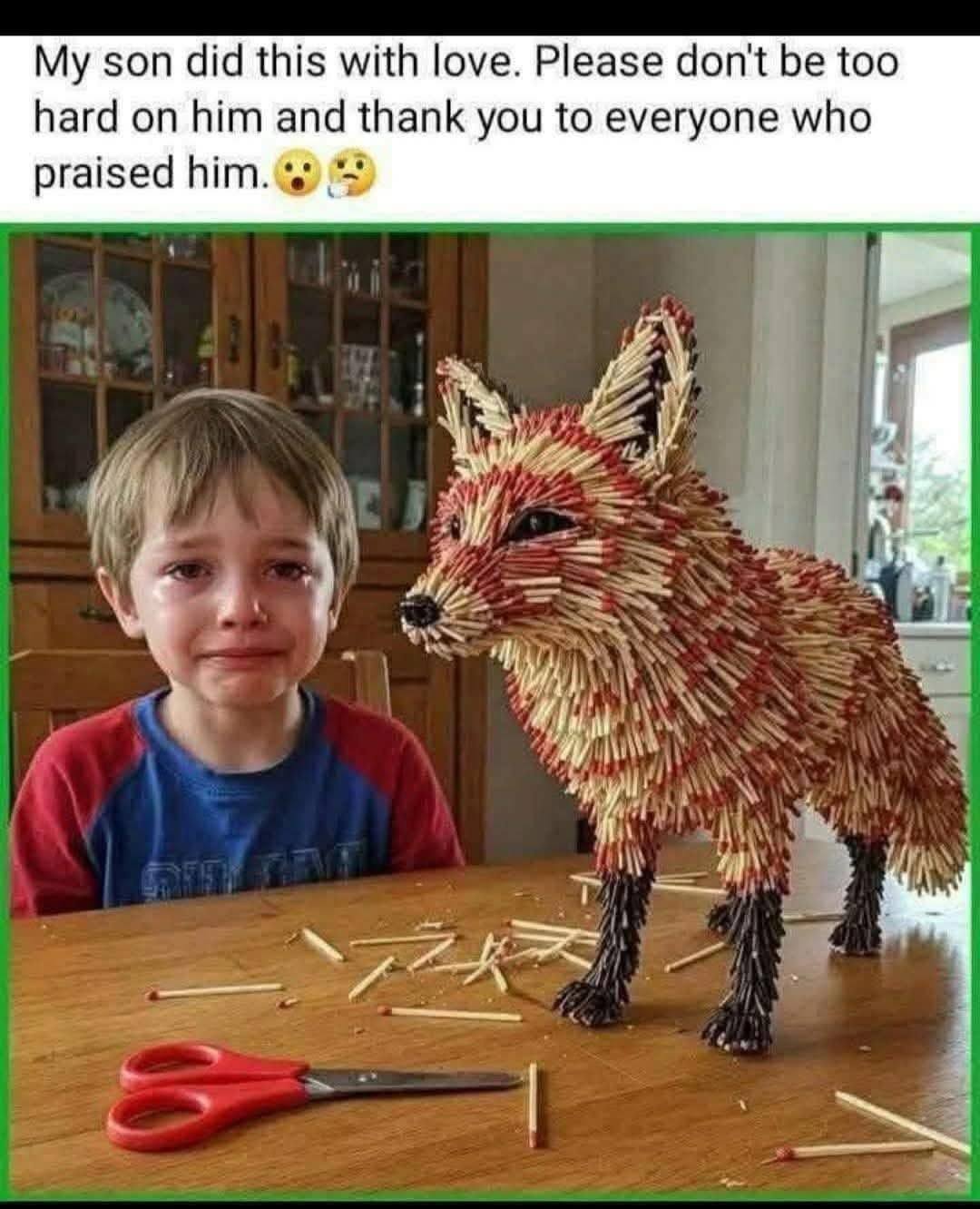The Heart of a Child: A Boy, a Fox, and a Thousand Matchsticks of Love

The Heart of a Child: A Boy, a Fox, and a Thousand Matchsticks of Love
In a world often defined by haste and harsh judgments, a single image can pause time, touch hearts, and remind us of the purity that still exists in innocence. One such image—of a young boy, tear-streaked and red-eyed, sitting beside an intricate sculpture of a fox made entirely from matchsticks—has captivated hearts across the internet. The caption reads: “My son did this with love. Please don’t be too hard on him and thank you to everyone who praised him.” What follows is not just a story about art or craftsmanship, but a deeper reflection on childhood, creativity, emotion, and the fragile beauty of expression.
A Masterpiece Born of Innocence
The sculpture itself is a marvel. Standing on a wooden table, meticulously formed from hundreds—possibly thousands—of matchsticks, the fox is striking in detail and personality. The gradient of colors, the positioning of each piece, and the sheer patience required all suggest a labor of immense care. At first glance, one might assume the work is that of a seasoned artist or a dedicated hobbyist. But then, you see the boy.
His eyes are red from crying. His face is swollen with emotion. His little hands rest near a pair of scissors and scattered matchsticks, as if the creative act has just ended or perhaps been interrupted. The contrast between the brilliance of the fox and the sorrow in the boy’s face is what makes the image unforgettable. It speaks volumes without needing words.
What prompted those tears? Was he scolded for using matchsticks—objects often associated with danger and disobedience? Was he frightened by the reaction of an adult who perhaps didn’t see his intent, only the perceived risk? Or were those tears of overwhelmed emotion, the result of praise or recognition too large for a child’s heart to hold?

The Raw Purity of Children’s Intentions
Children create not for fame or validation but out of curiosity, passion, and an unfiltered desire to bring their imaginations to life. The boy in the picture didn’t build a matchstick fox to win an award or go viral. He likely created it out of fascination—maybe a love for animals, or a desire to surprise someone dear. Every stick placed was a choice, every layer an act of love and effort.
As adults, we often forget what it means to create just for the joy of it. We measure value by utility, safety, or productivity. But children measure worth in moments—moments of fascination, joy, or wonder. This boy’s matchstick sculpture is a testament to that kind of value.
Even if the materials he used were unconventional—even risky—it’s crucial to recognize the heart behind the act. Supervision, yes. Safety education, of course. But condemnation? No. What the boy deserves, more than anything, is understanding and praise.
The Internet Reacts: From Judgment to Celebration
When the image first surfaced online, it stirred a mixed storm of emotions. Some adults were quick to question the wisdom of giving a child access to matchsticks. Others worried about fire hazards. But those voices were quickly drowned out by waves of encouragement, support, and awe.
Artists and educators praised the creativity and craftsmanship. Psychologists highlighted the importance of nurturing such raw talent. Parents saw in the image a reflection of their own children’s misunderstood efforts. And people around the world simply responded with admiration, thanking the child for reminding them of what it means to pour love into something you make.
In a world often divided, the photo created unity—not around politics or ideologies, but around shared human emotion. It became a moment of global tenderness.
Lessons in Emotion: Why the Tears Matter
The boy’s tears are as important as the fox. In fact, they are inseparable from the sculpture. They tell us about the emotional vulnerability of young minds. They remind us that children, especially those who create, feel deeply. They invest themselves entirely, wearing their hearts not just on their sleeves, but in every part of what they do.
Perhaps the boy cried because he feared rejection. Maybe someone scolded him before seeing the full picture. Maybe he felt a loss—the end of a beautiful journey in which he had poured days or weeks of work. Or maybe, just maybe, he cried because someone finally saw what he made and told him it mattered.
There’s a unique kind of crying that only comes when someone finally understands you. If that was the reason behind his tears, then they were not tears of sorrow—but of overwhelming recognition.
Parenting with Patience and Perspective
The image also invites deeper conversation about how we respond to our children’s actions. Parenting, while beautiful, is often fraught with fears. We worry about injuries, accidents, and risks. And those fears are valid. But they must be balanced with the understanding that children must also explore, create, and make mistakes.
Rather than ask, “Why did you use matchsticks?”, we might ask, “What were you trying to make?” Instead of reacting with fear, we can respond with curiosity. Safety can be taught without crushing spirit. Discipline can be practiced without breaking the will to dream.
In this image, we are reminded of the power parents hold—not just to shape behavior but to shape how a child views their own potential. A few kind words, a moment of appreciation, can affirm a young soul for a lifetime.
The Fox: Symbol of Resourcefulness and Spirit
Symbolically, the fox has long represented intelligence, adaptability, and creativity. It’s almost poetic that the boy chose this particular animal for his sculpture. In folklore across cultures—from Japan to Native America to European fairy tales—the fox is revered for its wit, resilience, and grace.
Perhaps, unknowingly, the boy chose a creature that reflects his own qualities. Through patience and creativity, he gave life to a figure that embodies much of what he demonstrated in making it: a quiet brilliance, a resourceful spirit, and a heart full of wonder.

Art Without Rules
This image also calls into question how we define “art.” The world of art is filled with boundaries and expectations. Certain materials are acceptable. Others are dismissed. But children don’t see such limits. They see possibility.
The boy didn’t need a canvas or oil paints. He didn’t need approval or permission. He saw something ordinary—matchsticks—and turned them into something extraordinary. In doing so, he joined the ranks of creators who dare to look at the world not as it is, but as it could be.
True art doesn’t follow rules. It breaks them. It redefines them. And sometimes, it’s built one matchstick at a time by the hands of a boy who simply wanted to make something beautiful.
A Global Reminder of Tenderness
In times of cynicism and chaos, this image offers a breath of fresh air. It reminds us that kindness is powerful. That praise, when given with sincerity, can heal. That sometimes, behind the tears of a child, lies a story of courage and passion.
Social media often spreads toxicity, division, and superficiality. But every now and then, a photo like this comes along and reminds us why we still scroll, why we still share, and why we still care. It’s because moments like these cut through the noise and connect us to something real.
Where Do We Go from Here?
What can we take from this image, beyond a fleeting emotional reaction?
-
Encouragement matters. Whether a child builds with matchsticks or mud, recognize the effort, the vision, and the heart.
-
Creativity is delicate. Children need space to explore without fear. Nurture that space.
-
Tears are not weakness. Emotional expression is a sign of depth, not failure. Support it.
-
Parenting is a conversation. Ask, listen, and guide with gentleness.
-
Art can be anything. Even matchsticks can become masterpieces.
A Legacy of a Little Fox
The little boy in the photo might grow up and forget the exact day he made the fox. He might not remember the reactions, the praise, or even the tears. But something will remain with him—the deep sense that what he made mattered, and that his love, when poured into something, could create beauty.
And for the rest of us? We’ll remember the image. We’ll remember the fox. And we’ll remember that behind every child is a story waiting to be seen, a heart waiting to be heard, and a masterpiece waiting to be made.


